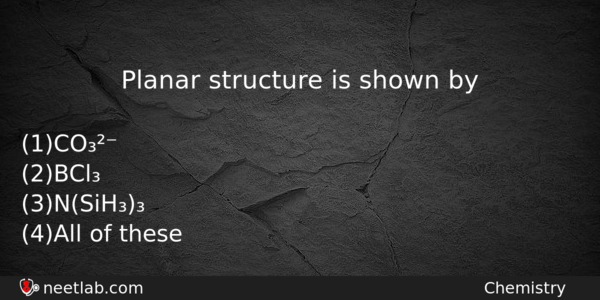| ⇦ | 
| ⇨ |
Planar structure is shown by
Options
(a) CO₃²⁻
(b) BCl₃
(c) N(SiH₃)₃
(d) All of these
Correct Answer:
All of these
Explanation:
C in CO₃²⁻ and B in BCl₃ are sp²-hybridised thus acquire planar geometry. Although N in N(SiH₃)₃ is sp³-hybridised but the steric hindrance caused by three bulky groups make it planar for higher stability.
Related Questions: - Acetanilide can be prepared,from aniline with
- On heating sodium metal in dry ammonia, the compound formed is
- Which of the following depends on the path followed
- Equal masses of H₂, O₂ and methane have been taken in a container of volume
- Which of the following is electron-deficient?
Question Type: Memory
(964)
Difficulty Level: Easy
(1008)
Topics: Chemical Bonding and Molecular Structure
(86)
Subject: Chemistry
(2512)
Important MCQs Based on Medical Entrance Examinations To Improve Your NEET Score
- Acetanilide can be prepared,from aniline with
- On heating sodium metal in dry ammonia, the compound formed is
- Which of the following depends on the path followed
- Equal masses of H₂, O₂ and methane have been taken in a container of volume
- Which of the following is electron-deficient?
Question Type: Memory (964)
Difficulty Level: Easy (1008)
Topics: Chemical Bonding and Molecular Structure (86)
Subject: Chemistry (2512)
Important MCQs Based on Medical Entrance Examinations To Improve Your NEET Score
18000+ students are using NEETLab to improve their score. What about you?
Solve Previous Year MCQs, Mock Tests, Topicwise Practice Tests, Identify Weak Topics, Formula Flash cards and much more is available in NEETLab Android App to improve your NEET score.
Share this page with your friends

Leave a Reply